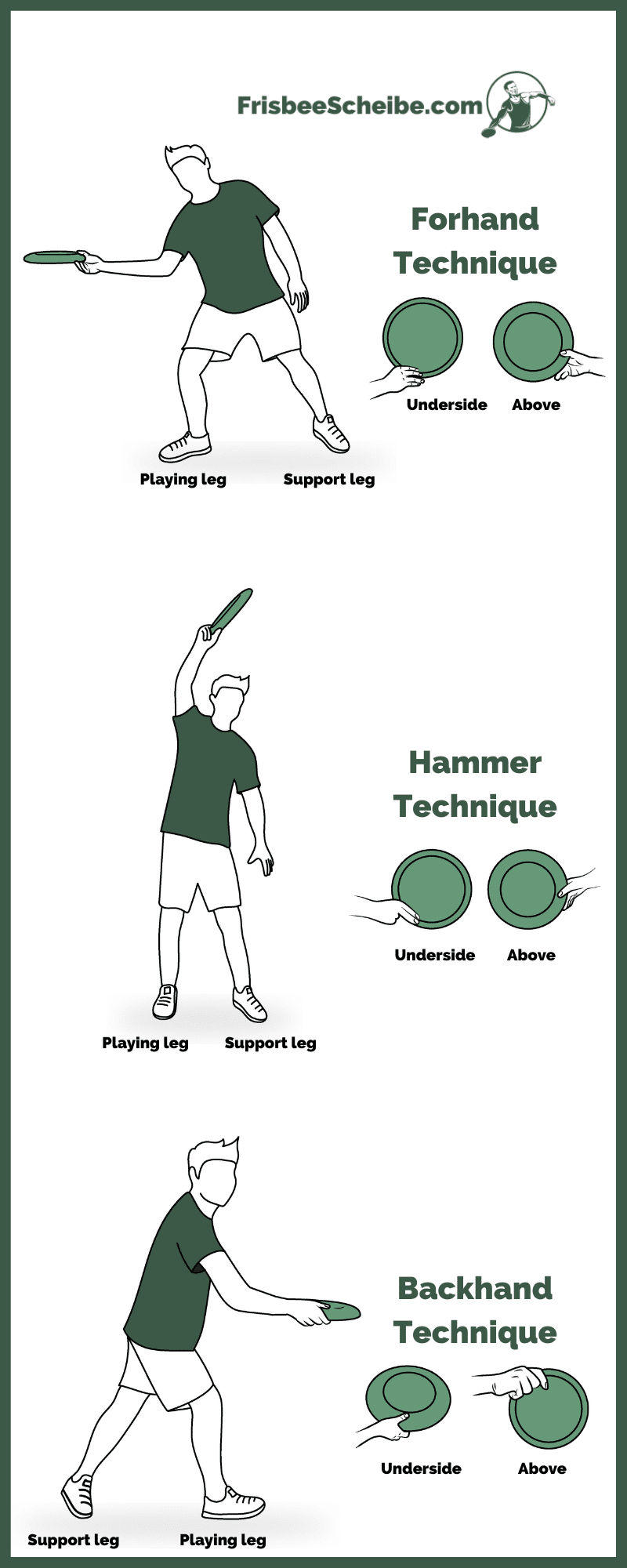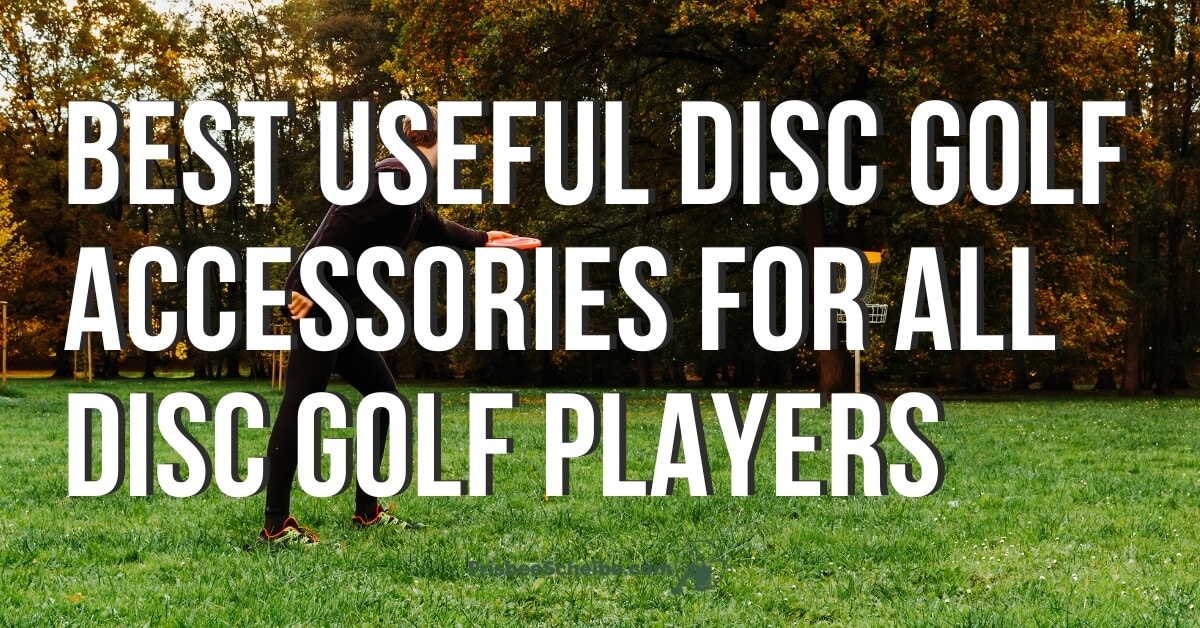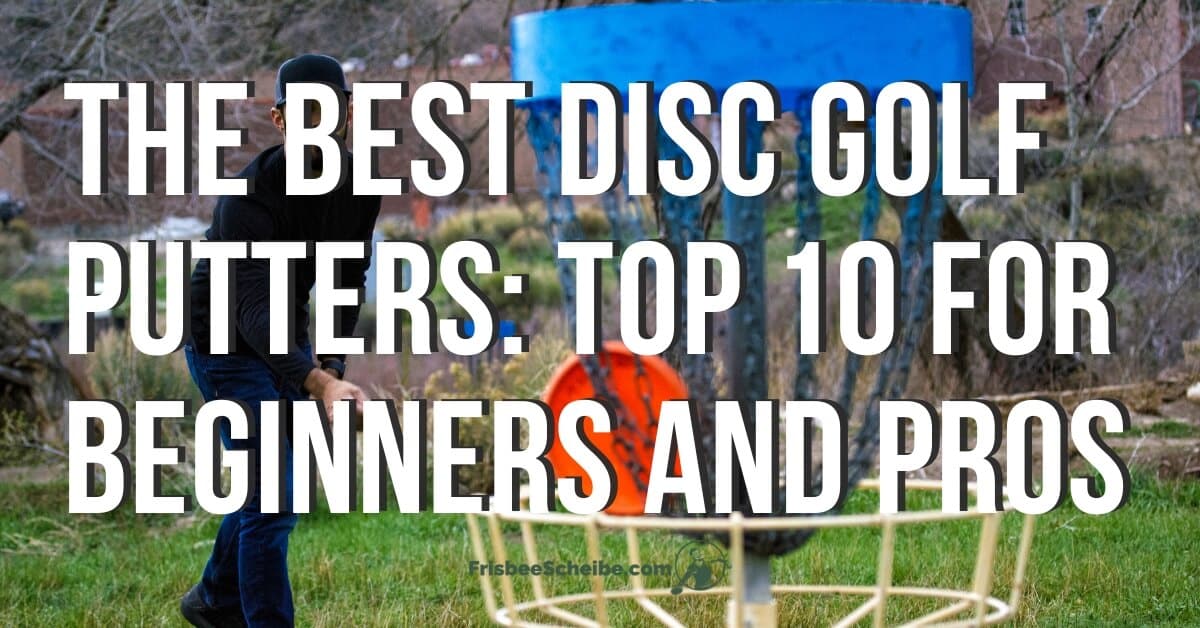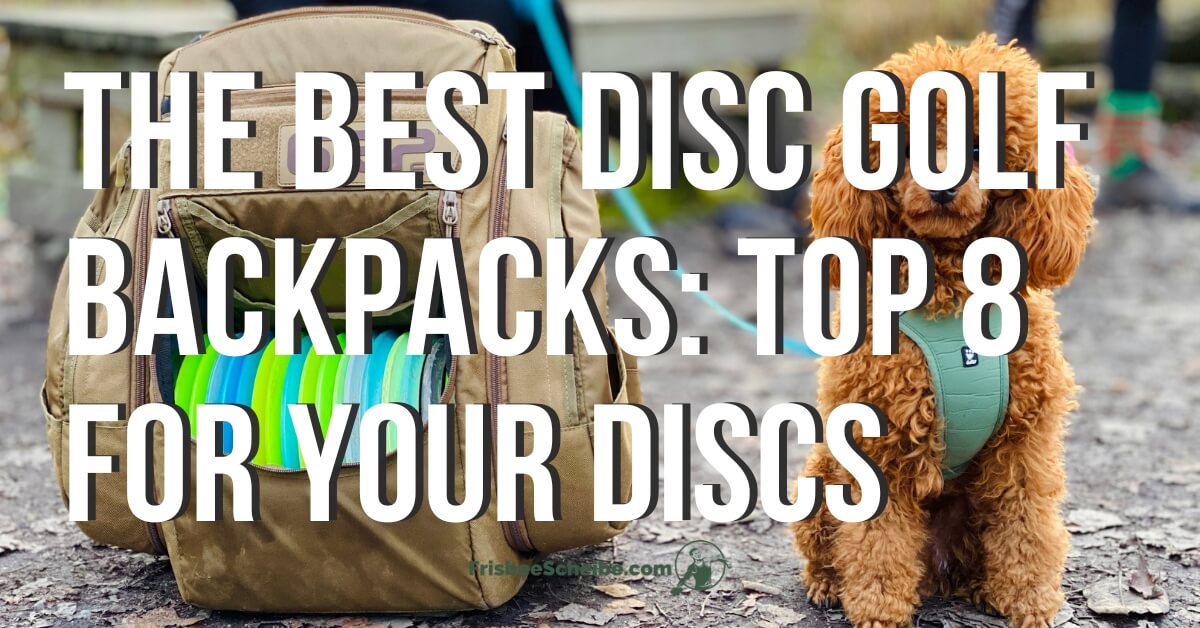A Frisbee as a plaything is already a good start. But of course, you’ll want to know, how to throw a frisbee. After all, it should not only travel well, but also be caught smoothly, right?
Frisbee Throwing Techniques Description
Forehand Throw
A little more difficult than the backhand throw, but not to be underestimated, especially for long throws!
- Beachhead: You stand with your legs slightly apart and your left foot further forward. Your hips and knees are slightly bent. You look over your left shoulder towards your target and hold the disc at stomach level next to your body.
- Grip: Your thumb holds the disc from above while your index finger points to the centre of the disc and your middle finger presses against the inside of the disc. You have tightened your ring and little finger.
- Throwing motion: First, lunge slightly backwards, letting your wrist bend outwards. Now bring your elbow forward as close as possible to your body. Make sure that your forearm is at about the same level as your hip when it passes your elbow. As soon as this is the case, snap your wrist forward. Important: The harder your middle finger presses the inner edge of the disc, the higher the rotation will ultimately be. Release the disc when your arm is almost fully extended and pointing outwards.
As with the backhand throw, you can combine the sidearm throw with a hyzer or anhyzer to change direction. Or you can do a lunge to irritate your opponent – just as you like.
Das Video wird von Youtube eingebettet. Es gelten die Datenschutzerklärungen von Google.
Backhand Throw
The backhand throw is by far the most frequently played technique in Frisbee throwing by beginners. It is no wonder that it is one of the first basics in school and club training because it is so easy to learn and can be used in so many ways.
- Beachhead: Stand sideways to the target and make sure the right foot is further forward. Bend the knees a little and look over the shoulder of the throwing arm.
- Grip: Place your thumb on the top of the target and grip the target from below with your other fingers. If you like, your index finger stretched on the outer edge of the target can help to stabilize the target. The palm of your hand lying there also contributes to this. The ideal stance is when there is a pistol-like 45-degree angle to the ground.
- Throwing motion: First, bring your throwing arm back towards your hip. Bend your wrist so that the inside of your forearm and the disc touch. When you start to gain momentum, you will notice that your upper body rotates slightly and the throw starts with the upper body continuing to rotate upwards. Open your elbow and stretch your arm. At the same time your wrist stretches (as quickly as possible!), which provides the last bit of speed. In the course of the throwing movement, shift your weight from your back leg to your front leg. If everything goes well, your hand will point in the direction of the target after the disc has been thrown.
By the way: A little hyze (left-handed curve for right-handers) or anhyze (right-handed curve) has never hurt anyone when throwing. The further you tilt the outer edge towards the ground (or the further away it points), the greater the left or right arc…
And depending on the Frisbee game, lunges can also be just the right thing to create a directional surprise. However, it is best to plan for this when aiming so that the Frisbee really lands where it is supposed to.

Hammer Throw
The hammer throw is also known as the upside-down throw. The reason for this is the disc flying upside down. How does this flight behaviour come about? You can see it here (for right-handers, left-handers simply mirror-inverted)!
- Beachhead: slightly bent hips and knees, legs slightly apart, with the left foot slightly forward. The view leads past the actual target on the left.
- Grip: Similar to the forehand throw; the thumb is on the top, the middle finger leans on the inside edge and the index finger points towards the centre of the disc.
- Throwing motion: Similar to that of other sports where a slap throw is one of the essential throwing techniques. Bring the shoulder of your throwing arm back and hyperextend your upper body. This creates the bow tension needed for the throw. To release this tension, your arm whips forward, pulling your elbow as close as possible to your head and your forearm overtaking your elbow. At the same time your wrist is maximally hyperextended and comes forward at the end of the movement. Ideally, you increase the pressure of your middle finger on the disc in the course of this movement, which additionally pushes its rotation. Also important: the weight shift (from back to front) and the stretching of the body at the end of the whole movement.
Das Video wird von Youtube eingebettet. Es gelten die Datenschutzerklärungen von Google.

- 9" Diameter, 100% Silicone
- Set of (6) Colors
- Perfect for young kids to learn throwing, catching
- The world standard for the sport of Ultimate
- Official and exclusive disc of the USA Ultimate Championship Series since 1991.
- 175 grams
Special Frisbee throwing techniques
Throwing a Frisbee and throwing a Frisbee are completely different pairs of shoes. In addition to the three most common techniques just explained, there are many other variations that you could also try out. For example the following…
Airbounce Throw
When you airbounce, you hold the disc at the top edge so that it is at a 45-degree angle. The underside should point in the direction of the throw. At the same time, the ideal throwing height is at knee height. Don’t forget a good backhand spin and the angle and spin will ensure that the disc initially rises a few feet into the air before it slowly starts to hover.
Das Video wird von Youtube eingebettet. Es gelten die Datenschutzerklärungen von Google.
Upside Down Throw
The upside-down throw described earlier is very practical in that the flight characteristics also diverge due to the changed position in the air, which makes it more difficult for your opponents to catch the disc immediately in the various Frisbee games. Perfect for a surprise throw.
Das Video wird von Youtube eingebettet. Es gelten die Datenschutzerklärungen von Google.
Chicken Wing Throw
Well, does the chicken wing throw remind you of a backhand throw? Not entirely without reason, because they are really not completely dissimilar. The difference is that you don’t throw across your body with a pull-back to generate spin, but you trigger the disc rotation with a wrapping motion. To achieve this, you grip the disc and roll your wrist, elbow and shoulder in a way that places the disc under your armpit. Now, for right-handers, follow with a backward step with the left leg and a slight twist in. Now all you have to do is relax like a spring and send the Frisbee on its way at the end of the movement. Voilà! (For left-handers, the right leg is of course relevant).
Das Video wird von Youtube eingebettet. Es gelten die Datenschutzerklärungen von Google.
Behind the Back Throw
To throw behind your back, if you are right-handed, hold the disc at a slight angle to your left hip. Then step forward with your left foot. Finally, reach behind your back and launch the disc at the end of this movement, turning to the right.
Das Video wird von Youtube eingebettet. Es gelten die Datenschutzerklärungen von Google.
Under the Leg Throw
The under-the-leg throw can be thrown backhand or forehand. You need to bring your leg up as far as possible and your arm down as far as possible so that the disc can slide off fairly flat and parallel to the ground. Additional tip: Get the maximum amount of momentum from your wrist, as your arm movement is logically somewhat restricted by the leg.
Das Video wird von Youtube eingebettet. Es gelten die Datenschutzerklärungen von Google.
Restricted Throw
Restricted Throws are core elements of Freestyle Frisbee because they can be played without a partner to catch. And yes, the choice is virtually endless, with among others the…
- Body Roll,
- Tip Tap
- Against the spin or
- Behind the back Swoop
are among the real classics. If you want to make your own instructional picture, try the corresponding Freestyle Frisbee article!
Das Video wird von Youtube eingebettet. Es gelten die Datenschutzerklärungen von Google.
Throw the Frisbee so it comes back
If you want to get the Frisbee back, you should definitely try the Self Set Throw. It is important to find a position where you can use the tailwind. Then put a backhand grip on the disc (centre of the rim on the far right) and raise your arm including an elbow turn (45 degree angle, your hand grip is exactly in front of you). Now you only need to give the disc a wrist twist. As a result, it floats upwards a little and then fairly straight back down.
Das Video wird von Youtube eingebettet. Es gelten die Datenschutzerklärungen von Google.
How to throw a frisbee as far as possible?
Although the backhand throw is the most common variant in Frisbee play, the forehand throw is the one that achieves the best results in the distance game. The following aspects are important for ideal acceleration:
- The angles should be right. You need a starting position in which you are standing at a 90-degree angle to the direction of the throw – your pelvis and shoulder show you the way. And the angle at the end of the throwing motion between the shoulder and pelvic girdle should be well above 45 degrees. A simultaneous overstretching of the wrist in the preparation phase, with the front edge of the target already pointing slightly towards the ground, also provides an additional acceleration plus.
- The more stable you are and the straighter your movements, the better you can use the momentum.
So everything is actually logical, but it’s still a question of timing and regular practice. And if something does go wrong, it could be due to one of the following aspects…
Das Video wird von Youtube eingebettet. Es gelten die Datenschutzerklärungen von Google.
Problems throwing the Frisbee
Your Frisbee is not flying as far as you would like it to? This could be due to one of the following problems!
- Wrong throwing angle. If the outer edge of the disc is regularly too high, it helps to throw it more often under the leg associated with the throwing hand. This way you will practice keeping the outer edge lower by yourself – and you will get more spin for free.
- Discs that are thrown too unsteadily. Always keep the disc level – and make sure that the wind doesn’t get under the disc when you throw it.
- The spin is too low. This happens especially with the combination of “strong wind and a rather low-quality disc”. Make sure that during the catapult movement the elbow really pulls all the way forward before the arm swings through after the disc is thrown. This movement should be continued until the target and hand are in as exact a line as possible.
- Short distance. It’s all a question of practice and muscles! Once you’ve got the technique right, the distance is only a question of increasing strength.
- Tilting the Frisbee to the left when throwing overhead. If the disc overturns, you have probably set the tilt angle too shallow when throwing it. Set the disc up more steeply next time. This will help you to compensate for the tendency to tilt.
- No horizontal flight, but vertical tipping and landing. In this case, the solution is to look for the exact opposite, i.e. a slightly more horizontal launch angle.
- The disc does not reach the target, but comes to a halt in front of it or too far to the right. This is usually caused by an incorrect overhead aiming point. A too flat aiming angle prevents the target from reaching a sufficient distance. If the target is flying too far to the right, it helps to aim further to the left and higher above the target.
Learning to catch a Frisbee correctly
Not only throwing the Frisbee – also catching it is part of the basic concept of various Frisbee games. The following three catching techniques are essential:
- The pancake or sandwich catch. In keeping with its name, it is executed in such a way that the disc is framed and pinned down by both hands, like a sandwich covering, from above and below.
Das Video wird von Youtube eingebettet. Es gelten die Datenschutzerklärungen von Google.
- The two-handed catch at the edge. In contrast to the pancake catch, the entire hands are not placed on the centre of the disc. Instead, the thumbs are placed on the top of the Frisbee and the other fingers on the bottom.
Das Video wird von Youtube eingebettet. Es gelten die Datenschutzerklärungen von Google.
- The one-handed catch to the edge. It is more or less identical to the variant just mentioned, but you execute it with only one hand.
Das Video wird von Youtube eingebettet. Es gelten die Datenschutzerklärungen von Google.
But of course these are by far not all possible techniques. In the area of freestyle frisbee, there are also the…
- Behind the Back Catch,
- Chair,
- Under the Leg,
- Triple Fake Catch or
- Flamingo Osis Catch
… extremely popular.
- The world standard for the sport of Ultimate
- Official and exclusive disc of the USA Ultimate Championship Series since 1991.
- 175 grams
How to throw Frisbee: Conclusion
Whether …
- Backhand Throw,
- Sidearm Throw or
- Upside-Down:
All throwing techniques require a skilful disc stance and a flowing movement. A stable stance is just as important as the right angles and the ideal finishing moment. Or in other words: sometimes you have to know when it’s time to let go. 😉 However, this has much less to do with heartbreak and tragedy than with fun. Of course, the more different tricks you have up your sleeve and the more skillful you are at catching them, the more fun you will have. The best way to keep developing is to practise, practise, practise. Whether alone or together with your best friends is of course up to you.
Sources & credits:
[1] https://www.mobilesport.ch/assets/lbwp-cdn/mobilesport/files/2011/05/Hilfsmittel_pb39_p5-11_d.pdf
[2] https://www.frisbee-ooe.at/ultimate-frisbee/das-spiel/wurftechnik/
[3] https://www.frisbeesportverband.de/images/dfv/dfv_juniorensport/downloads/Schulport-Leitfaden.pdf
[4] http://www.fssport.de/texte/Frisbeeburg.pdf
[5] https://de.wikihow.com/Eine-Frisbeescheibe-richtig-werfen
[6] https://knsu.uni-koblenz.de/weitere_sportbereiche/wurfscheibe/th_techniken_zum_werfen_der_wurfscheibe/th_techniken_zum_werfen_der_wurfscheibe.pdf






